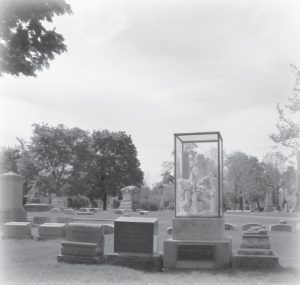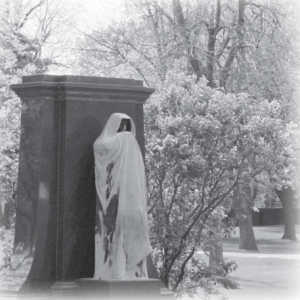The Ghosts of Graceland Cemetery
by Jeff Morris and Vince Sheilds
Directions From the center of Chicago, take US-41 North for about 4 miles to the Irving Park Road exit. Turn left onto Irving Park Road and follow it for about 1 mile. Turn right onto North Clark Street. The entrance to Graceland Cemetery will be on your right, at the corner. The address of the cemetery is 4001 North Clark Street, Chicago, Illinois 60613.
 History From its inception in 1860, the cemetery has always been a private one. Its creator, Thomas Bryan, wanted it to stand apart from many local cemeteries of the time in order to gain business. He wanted it to look like the most beautiful and peaceful place in the city. He hired landscape architects to design the grounds. Famous area sculptors created many of the tombstones. Bryan succeeded in making Graceland one of the most attractive spaces in the city.
History From its inception in 1860, the cemetery has always been a private one. Its creator, Thomas Bryan, wanted it to stand apart from many local cemeteries of the time in order to gain business. He wanted it to look like the most beautiful and peaceful place in the city. He hired landscape architects to design the grounds. Famous area sculptors created many of the tombstones. Bryan succeeded in making Graceland one of the most attractive spaces in the city.
Throughout the many years that the cemetery has been in operation, many of the area’s most famous people have been buried here. The first white settler of Chicago, John Kinzie, is buried here. Assassinated Chicago mayor Carter Harrison is buried here. Department store magnate Marshall Field, private eye Allan Pinkerton, and Charles Dickens’s brother are all also buried here.
One of the most famous markers at the cemetery is for a girl named Inez Clarke. Many verifiable historic documents regarding this girl have been lost to history. In fact, cemetery records state that no one named Inez Clarke is buried at the cemetery. Inez is more likely a girl named Inez Briggs, daughter of Mary Clarke from a previous marriage. According to many local legends, though, Inez Clarke (1873-1880 on her marker) was at a family picnic when she was struck by lightning and killed. Distraught, her family had a likeness of her built and placed in a glass box aboveground to mark where she was buried.
 Ghost Story Throughout the cemetery, people sometimes detect unexplainable drops in temperature. Perhaps this is caused by one of the departed residents walking past. These temperature fluctuations would be the most widespread hauntings in the cemetery, if not for two eerie monuments.
Ghost Story Throughout the cemetery, people sometimes detect unexplainable drops in temperature. Perhaps this is caused by one of the departed residents walking past. These temperature fluctuations would be the most widespread hauntings in the cemetery, if not for two eerie monuments.
The first is called Eternal Silence, and it is the family stone for the Graves family. The marker is an admittedly creepy statue of a robed figure with a hood. Legend says that if you look into the face of the statue, you will catch a glimpse of your own death. Further, it is said that the statue is impossible to clearly photograph and that cameras will malfunction when aimed at the statue. Plenty of photographs exist of the statue, so apparently cameras do not malfunction all the time, but people do still report malfunctioning cameras from time to time when they attempt to photograph the statue.
The second monument is the statue of Inez Clarke. Strange sounds are often heard near the marker. People hear footsteps and whispers in this vicinity. They also hear crying. However, many of the more famous stories about the marker involve the statue itself. There are several accounts of the statue completely vanishing without a trace. A girl who resembles the statue has been seen wandering through the cemetery and then vanishing. This happens most often during thunderstorms, perhaps in reference to the supposed cause of the girl’s death by lightning strike. Sometimes, people see the glass box, but it is completely empty. A particularly famous story of this phenomenon occurred in the late 1800s, when the night watchman at the cemetery experienced exactly that and fled the cemetery, never to return.
Visiting The cemetery is open daily, 8 a.m.–4:30 p.m. You may not enter the cemetery at any other times. Your best bets for experiencing something paranormal here would be to go to one of the two haunted monuments in the cemetery. You should try to take pictures of Eternal Silence to see if anything strange occurs and maybe approach the Inez Clarke marker during a thunderstorm.
For 99 ghostly places you can visit in and around the Windy City, check out the Chicago Haunted Handbook by Jeff Morris and Vince Sheilds.